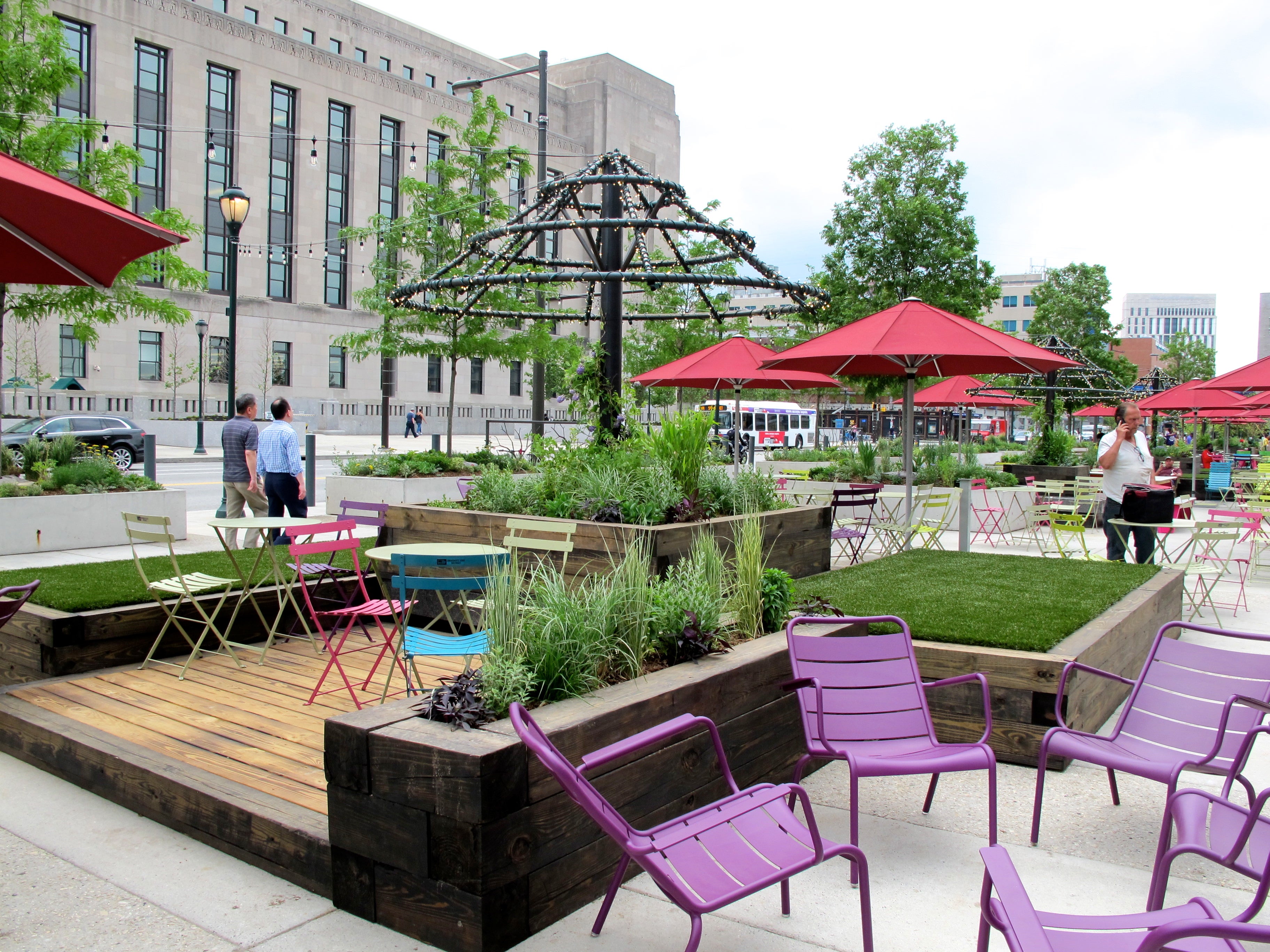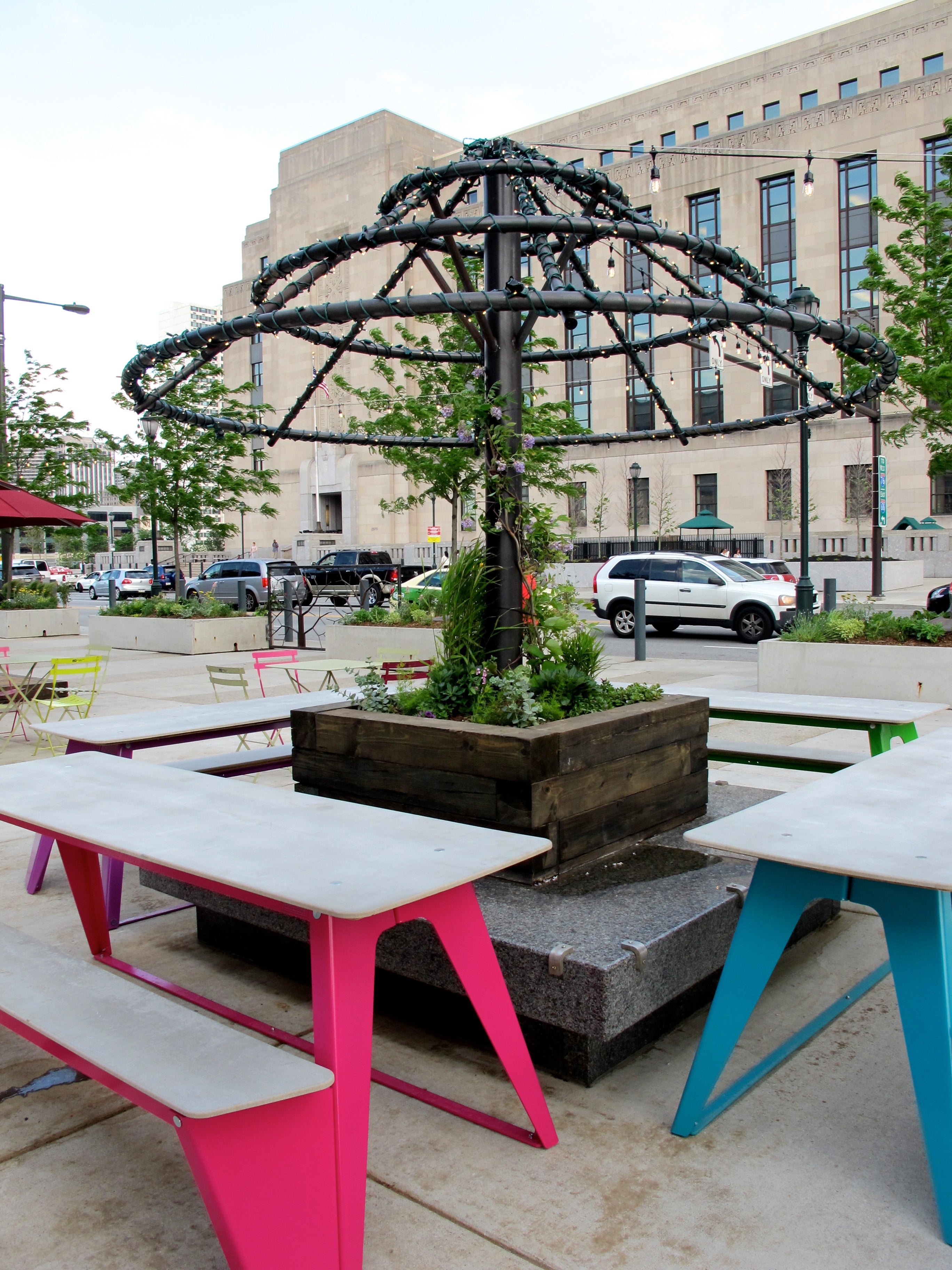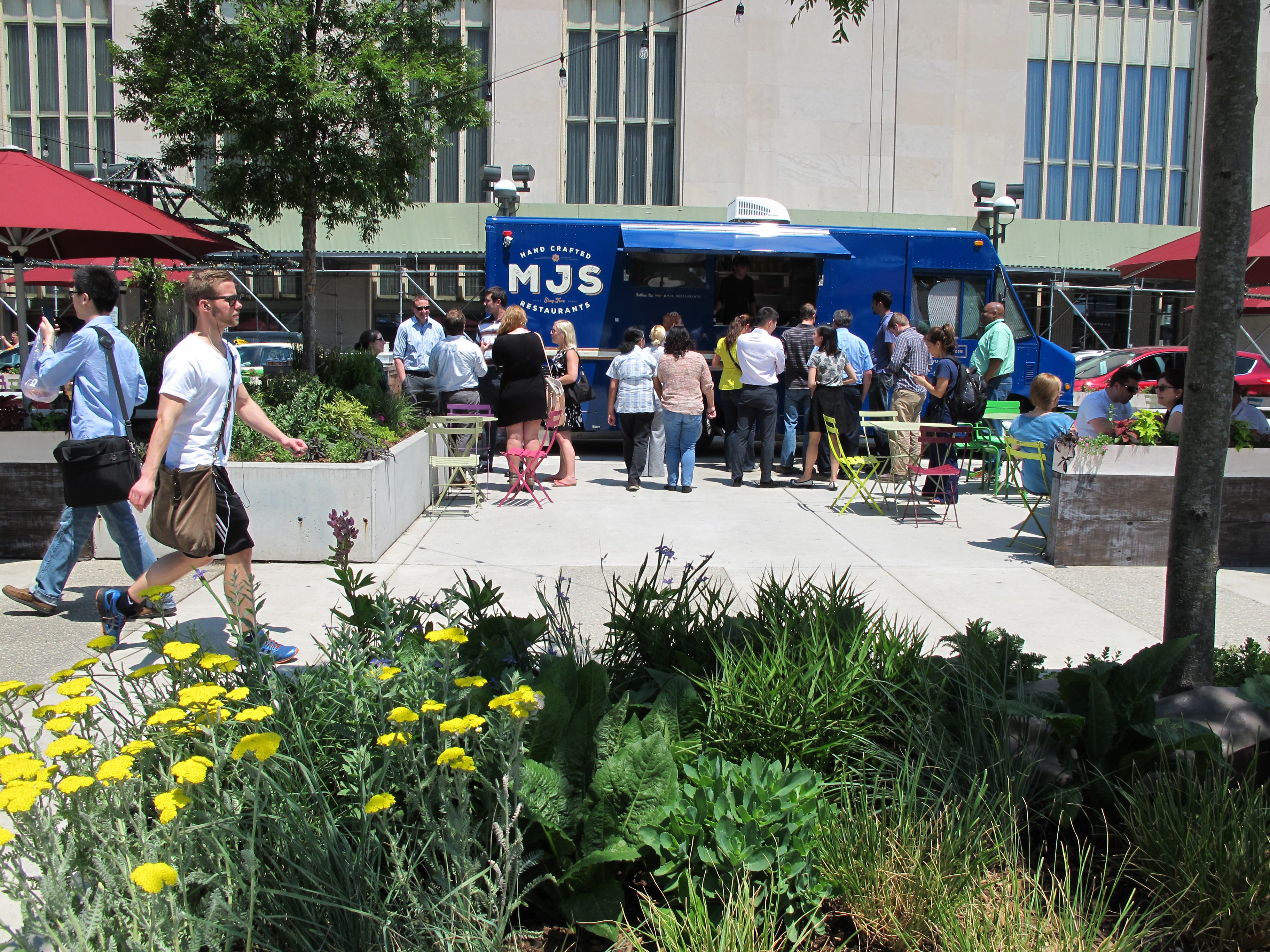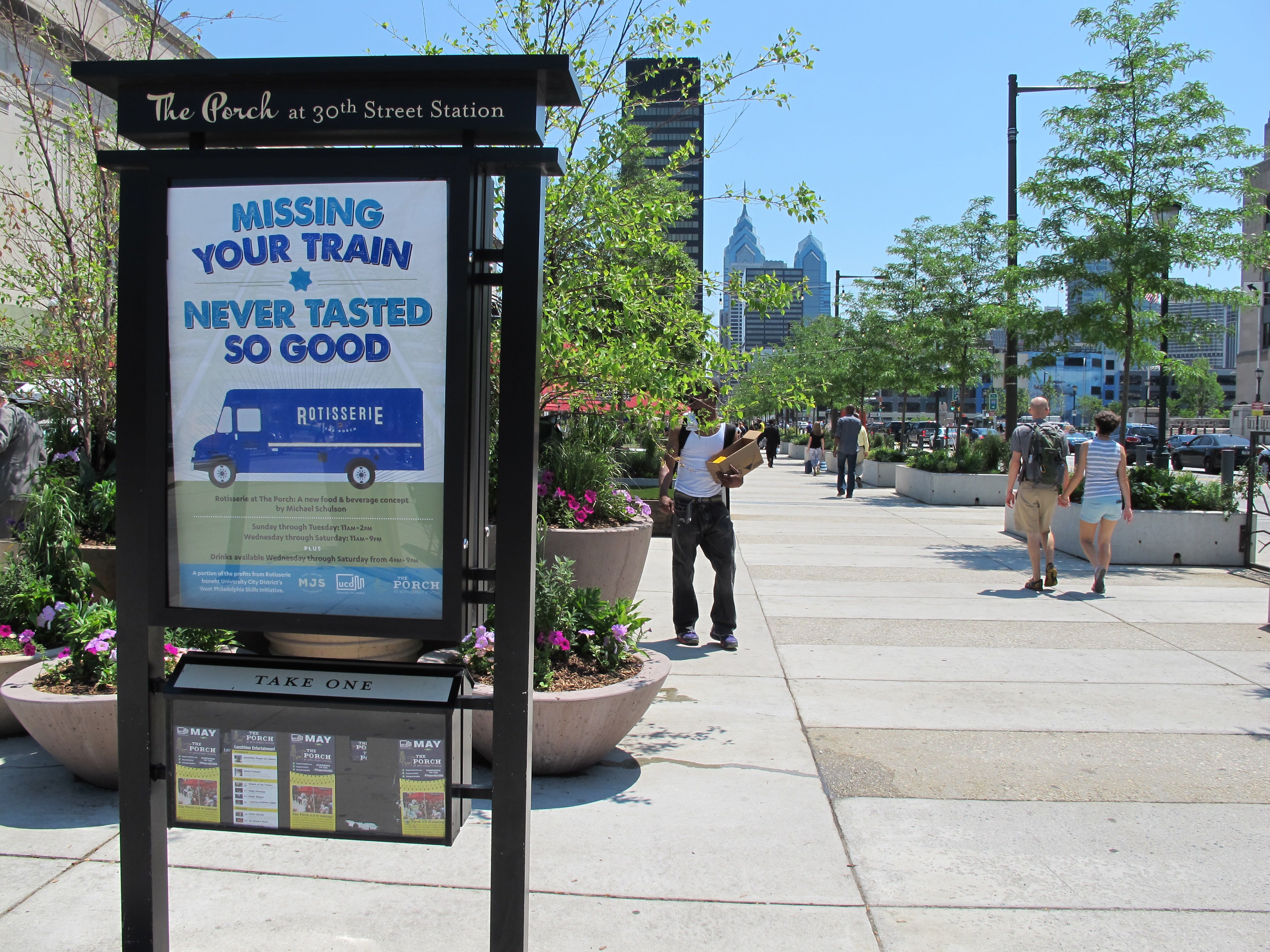The Porch 2.0: Updated version, same big vision

When University City District (UCD) opened The Porch at 30th Street Station in November 2011, it was a pretty barebones affair.
Putting movable furniture on a 50-foot wide slip of concrete outside 30th Street Station was a bold trial in “lighter, quicker, cheaper” placemaking, but the huge expanse felt lonesome and bare.
Since then, The Porch has steadily been growing up, moving from meh to more mature. This month UCD launched The Porch 2.0, a new version born from three and a half years of tiny tweaks, careful observations about how people use the space, and experiments in programming.
“If initially the play was to prove that people would linger in the space I would say we were wildly successful,” said Prema Katari Gupta, UCD’s director of planning and economic development. Now that The Porch has proven itself as a real public space, particularly well used by lunch crowds on nice days, the question became how to extend the hours of animation. The test for Porch 2.0: proving The Porch is a place people will spend their evening hours.
UCD, which manages The Porch, hired the design-build firm Groundswell Design Group to help create a new iteration of The Porch. Their charge: Create a more comfortable, verdant public space that’s welcoming at more hours of the day. The task: Help create a more stable public space out of one that’s otherwise known for temporary, experimental interventions.
Groundswell’s David Fierabend said they took everything already at The Porch – granite platforms, concrete planters, bright furniture, and umbrellas – as the foundation for the transformation.
Joining the trademark colorful bistro chairs umbrellas and planters are terraced seating nodes and planters that break up the 565-foot long expanse.
“We developed a modular language of tiered platforms, all based off the existing 7’x7′ granite platforms and 12’x6′ concrete planters, and created three different types of module; traditional porch decking, turf for a green, and actual planters to allow us to really pump up the planting and lushness of the space,” said Fierabend over email.
Granite platforms became the bases for large new planters – built of new railroad ties in a very Groundswell nod to the train station location – that double as benches for the new rainbow of picnic tables. Concrete planters anchor the tiered nodes, with those mini-porches and turf zones. The result are intimate, layered nooks that help define human-sized spaces, that also can be reconfigured over time.
At the center of some clusters are metal toadstool-shaped trellises, which wisteria is starting to climb. Fierabend explains these are intended as a “green interpretation” of a patio umbrella, which will be lush in summer and sculptural in winter. As the vines grow, he said, these structures will “create a living, breathing, swaying umbrella for people to sit under. They are also strung with white twinkle lights to “bring that warm, firefly, porch vibe in.”
The Porch 2.0’s plantings are decidedly lusher and less corporate feeling than seen in prior seasons, softening the vast hardscape with new layers of height, texture, and color.
“We definitely took advantage of some of the site analysis, and noticed that there is always a nice breeze blowing through the space. We also took note of the amount of movement on and around the Porch, both pedestrian and vehicular. It was these two aspects that played a part in choosing a lot of native grasses that really sway in the breeze and help to further reinforce that movement on The Porch through an organic and natural sense,” Fierabend said.
Along the Market Street edge new metal tree-silhouette screens stretch between several planters and divide the street’s traffic from pedestrian zone of the Porch. These too will soon be covered with vines. Already they’re being used as bike racks, an unpredicted but welcome use, Gupta said.
Adding to The Porch 2.0’s new identity is a shift away from a rotating cast of food trucks in favor of a single fixed café area by restaurateur Michael Schulson. (Schulson and Groundswell have collaborated previously, most recently in the creation of the Independence Beer Garden.)
Schulson created a “rotisserie” themed permanent food truck for The Porch, in part because that was an easy way to add a kitchen to the site. Though mobile the plan is for the truck to stay parked on The Porch and only be used there. Schulson’s catering license also makes serving wine, beer, and cocktails possible in the café zone, blocked off by planters. The truck will serve lunch daily 11am-2pm, and from Wednesday through Saturday drinks will join the food until 9pm.
While a singular food option diminishes the novelty and variety that characterized The Porch’s earlier incarnation, stability has advantages too.
“[Schulson is] as committed to the success of the site as we are, and our goals are very closely aligned. It’s a much more meaningful relationship than the plug and play food truck,” Gupta said.
The collective effect of The Porch 2.0 is a more grounded and grown-up public space that looks like it intends to stay and continue to evolve alongside the growing neighborhood.
UCD has long hoped that The Porch can be a place that actively supports the ever-growing population in eastern University City. As it continues to evolve the hope is that The Porch can support public life in a neighborhood, where cranes overhead point to the thousands more residents and workers that will soon spend their days – and nights – in eastern University City.
Public spaces like The Porch are what UCD considers civic infrastructure. In addition to being a welcoming public place, its higher purpose is as platform for unexpected, creative collisions among University City’s inhabitants. Can public space lead to collaboration, innovation, and interaction? Who knows what ideas or relationships can sprout over lunch or happy hour.
WHYY is your source for fact-based, in-depth journalism and information. As a nonprofit organization, we rely on financial support from readers like you. Please give today.








